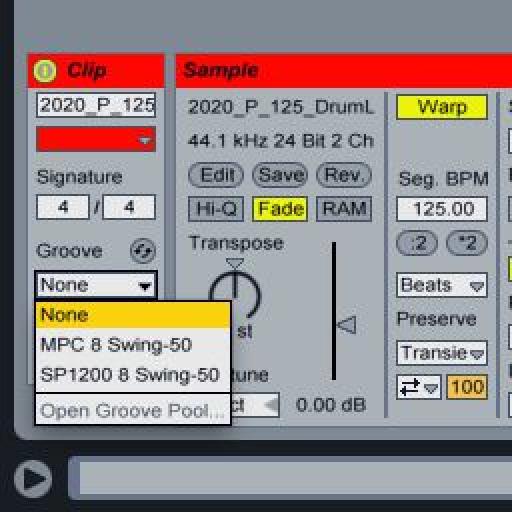Ableton is perfect for programming your own beats but without the right attention to detail things can start to sound a little robotic. Using Live's built in groove engine you can not only add a little swing to proceedings but generally make things sound more human.
Accessing The Groove Engine
Regardless of whether you want to apply your groove to a MIDI clip or warped audio loop (we'll be using the latter) you will access Live's groove engine in the same way. You should notice a small icon made up of three waves in the lower left hand corner. You'll find it just below the browser area.
Hit this small button and you'll be presented with the 'Groove Pool' window. This is essentially an area where you can drag and drop groove templates to. These grooves can then be used on any clip loaded into your active project.

The Groove Pool.
If you right-click anywhere within the groove pool you are able to select 'browse groove library'. This will bring up all the available groove templates in Live's factory library. There are an impressive amount of templates here and the library represents grooves from classic drum machines, other DAWs and even live performances.
Try dragging some of these grooves to the groove pool. You can build up a list of templates you want to use or audition at this point. As you can see from the shot below I dragged in a few classic grooves from the Akai MPC and SP1200. We are now ready to start applying the grooves to our audio.

Grooves are dragged to the Pool.
Applying A Groove To A Clip
Once you have your grooves loaded applying them to a clip (either MIDI or audio) is relatively straight forward. Simply select the groove in question and navigate to the info window at the bottom of Live's interface.
At the far left of this window you'll see a 'Clip' area and below this an option to select a groove. Using this drop down menu will display the grooves in the groove pool and any of them can be highlighted.
Applying a groove to a clip.
With your groove applied you should be able to hear it adjusting the timing of your loop. If you prefer you can actually use Live's 'hotswap' system to audition loops. Hit the hotswap icon in the clip area and you will be able to audition loops straight from the groove library.
Try several grooves to hear the different effects each one has on your sequence, here you can hear that the drum loop used is pretty drastically changed. Once you have chosen your groove you are ready to alter its settings and imprint in to your clip.
Tweaking And Imprinting Your Groove
Altering any aspect of your grooves is simple and totally non destructive. Each entry in the groove pool has a number of parameters available for tweaking, some of them make more noticeable changes than others but try altering them all to get a feel for what they do.
Quantize will ensure that each slice or MIDI event is in line before the groove is applied, very useful for live samples or performances. You can then apply varying amounts of groove to the timing and velocity of the part. You can even add some random timing to make things even more 'human'.

Adjusting a groove's parameters.
When you are happy with result you can 'commit' the groove to your clip. This will make any changes permanent and the clip can then be saved with your new groove information embedded. The groove will then be removed from the clip.
The groove is imprinted!.
A loop pre-groove:
The same loop with a subtle MPC based groove added:
Hopefully you can use this simple method to inject a little more feeling into your parts and make them a touch more human!





 © 2024 Ask.Audio
A NonLinear Educating Company
© 2024 Ask.Audio
A NonLinear Educating Company
Discussion
Want to join the discussion?
Create an account or login to get started!